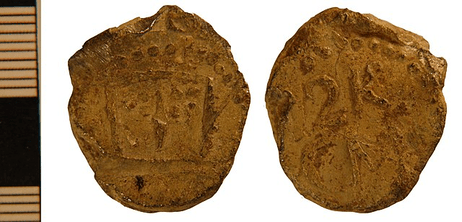Discovering the Source of Metal Artifacts using Lead Isotopes
 Lead (Pb) has four stable isotopes (204Pb, 206Pb, 207Pb and 208Pb) which are commonly used in archaeological studies, particularly in the case of connecting metal artifacts to their relevant geological or mine sources. Such research – also known as provenance studies – is reliant on the theory that the geochemical properties of the original ore deposit from which the metal was derived from can be determined within the isotopic signature of a metal artifact despite alteration in the process of its creation. When the source of a metal artifact is known, further analysis into trade relationships and movement of objects through time can be explored.
Lead (Pb) has four stable isotopes (204Pb, 206Pb, 207Pb and 208Pb) which are commonly used in archaeological studies, particularly in the case of connecting metal artifacts to their relevant geological or mine sources. Such research – also known as provenance studies – is reliant on the theory that the geochemical properties of the original ore deposit from which the metal was derived from can be determined within the isotopic signature of a metal artifact despite alteration in the process of its creation. When the source of a metal artifact is known, further analysis into trade relationships and movement of objects through time can be explored.
Lead has been identified throughout history, with some of the earliest examples dating back to the 5th millennium BCE (Yahalom-Mack et al. 2015), with extensive use beginning in Ancient Egypt (Science, 2010). This was followed by the development of lead mining by the Romans – later expanding into Europe and Britain (Durali-Mueller et al. 2015; Montgomery et al. 2010).
Lead isotopes undergo a variety of processes from source mining to smelting, to refining and casting – ultimately leading to the development of artifacts where lead is a major (lead pigments and metals) or minor (glass, copper, iron, glaze, silver) element. While evidence varies, it’s been generally accepted that lead isotopes remain unchanged despite these processes (Macfarlane, 1999; Stos-Gale and Gale, 1999).
Types of metal artifacts
 The most common metals and metal-derived artifacts found in archaeological sites include:
The most common metals and metal-derived artifacts found in archaeological sites include:
- Cast & wrought iron※
- Copper (native)
- Copper alloys: bronze※, brass※
- Lead (native)†
- Lead pigments†
- Tin (native)
- Glass※
- Glazed ceramics※
- Tin & Lead alloys: pewter◊
- Silver※
- Gold※
† Always contains Lead
※ Can contain Lead
◊ Lead contained in lower grades versions
Metals that are made up of more pure elements (e.g. native copper) tend to be more challenging when analyzing source as the isotopic signature tends to overlap with many different potential source regions (Rapp et al. 2000). On the other hand, where metal artifacts are developed from impure sources with unique chemical properties (e.g. pewter), provenancing can be completed with more certainty (Copper and Simonetti, 2021). Recent advances in analytical capabilities have permitted more accurate archaeometallurgy investigation through the improvement of mass spectroscopy analysis certainty – currently approximately ±0.1% – sufficient to allow for the differentiation of lead isotopes from a variety of sources.
Lead Isotope analysis & interpretation
Once Lead isotopes have been established for metal artifacts, they must be compared to known isoscapes – maps of the spatial distribution of Lead isotope signatures. These are available in a variety of contexts, including:
- IBERLID database: covering the Iberian Peninsula and Balearic Islands
- OXALID database: e.g. Bronze Age artifacts (Greece, Bulgaria, Italy, Spain, Turkey), Roman and islamic classes & pigments, Coins (Greek, Celtic)
- GlobaLID database: a global set of >20,000 datasets of Pb isotopes of ores and minerals
Isobar Science offers Lead isotope ratio analysis using our in-house MC-ICP-MS are reported as 206Pb/204Pb, 207Pb/204Pb, 208Pb/204Pb, 208Pb/206Pb, and 207Pb/206Pb ratios with uncertainties represented as the 95% confidence interval. For an optimal measurement, 10 ppb of Pb is preferred in the sample, however, measurements can be completed at a minimum of Pb concentration between 5 ppb with higher uncertainty.
Samples accepted include: glass (100-150mg) and metal artifacts and coins (20mg). Contact us today to discuss your research!
Images
Gold-coated Lead statue from Parc de Versailles
Lead Metal token from the post-Medieval era
GlobaLID map highlighting the coverage of Lead Isotope reference data (Klein et al. 2022)
References
Cooper, H.K. and Simonetti, A., 2021. Lead Isotope Analysis of Geological Native Copper: Implications for Archaeological Provenance Research in the North American Arctic and Subarctic. Minerals, 11(7), p.667.
Durali-Mueller, S., Brey, G.P., Wigg-Wolf, D. and Lahaye, Y., 2007. Roman lead mining in Germany: its origin and development through time deduced from lead isotope provenance studies. Journal of Archaeological Science, 34(10), pp.1555-1567.
Klein, S., Rose, T., Westner, K.J. and Hsu, Y.K., 2022. From OXALID to GlobaLID: Introducing a modern and FAIR lead isotope database with an interactive application. Archaeometry.
Macfarlane, A., 1999. The lead isotope method for tracing the sources of metal in archaeological artefacts: strengths, weaknesses and applications in the western hemisphere. BAR International Series, 792, pp.310-316.
Montgomery, J., Evans, J.A., Chenery, S.R., Pashley, V. and Killgrove, K., 2010. ‘Gleaming, white and deadly’: using lead to track human exposure and geographic origins in the Roman period in Britain. Journal of Roman archaeology; supplementary series., pp.199-226.
Rapp, G.R., Allert, J., Vitali, V., Henrickson, E. and Jing, Z., 2000. Determining geologic sources of artifact copper: Source characterization using trace element patterns. University Press of Amer.
Science, 2010. Egyptian Eyeliner May Have Warded Off Disease. Archaeology News. doi: 10.1126/article.30976
Stos-Gale, Z.A. and Gale, N.H., 2009. Metal provenancing using isotopes and the Oxford archaeological lead isotope database (OXALID). Archaeological and Anthropological Sciences, 1(3), pp.195-213.
Yahalom-Mack, N., Langgut, D., Dvir, O., Tirosh, O., Eliyahu-Behar, A., Erel, Y., Langford, B., Frumkin, A., Ullman, M. and Davidovich, U., 2015. The earliest lead object in the Levant. PLoS One, 10(12), p.e0142948.
